

Menopause Transition and Cardiovascular Disease Risk: Implications for Timing of Early Prevention: A Scientific Statement From the American Heart Association. Obesity is associated with early hip fracture risk in postmenopausal women: a 25-year follow-up. The study population consisted of the ongoing Kuopio Osteoporosis Risk Factor and Prevention (OSTPRE) study cohort.
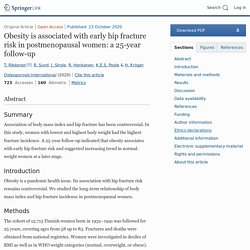
This population-based long-term follow-up study includes all the 14,220 Caucasian women born between 1932 and 1941 who lived in the Kuopio Province, Eastern Finland in April 1989. A postal questionnaire was mailed to 14,120 of these women at baseline in 1989 with 13,100 (92.8%) responding. The follow-up questionnaires were mailed at 5-year intervals (1994, 1999, 2004, 2009, and 2014) to women who responded to the baseline enquiry and were alive at the time. The response rate varied between 93% and 80% throughout the study. The OSTPRE study was approved by the Kuopio University Hospital Ethics Committee on 28 October 1986 and is performed in accordance with the ethical standards of the Declaration of Helsinki.
Polycystic ovary syndrome and aging: Health implications after menopause - Maturitas. Lizneva D.

Suturina L. Walker W. et al.Criteria, prevalence, and phenotypes of polycystic ovary syndrome.Fertil. Steril. 2016; 106: 6-15Yildiz B.O. Bozdag G. Yapici Z. et al.Prevalence, phenotype and cardiometabolic risk of polycystic ovary syndrome under different diagnostic criteria.Hum. The Mediterranean diet and menopausal health: An EMAS position statement - Maturitas. Menopause symptom management in women with dyslipidemias: An EMAS clinical guide - Maturitas. Management of depressive symptoms in peri- and postmenopausal women: EMAS position statement - Maturitas. Pharmacological Management of Osteoporosis in Postmenopausal Women: An Endocrine Society* Clinical Practice Guideline.
Skip to Main Content Sign In Register Close Advanced Search Online ISSN 1945-7197 Print ISSN 0021-972X Copyright © 2019 Endocrine Society Connect Resources Explore.
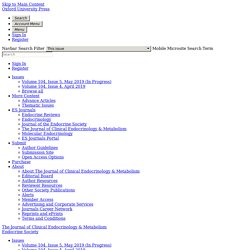
European guidance for the diagnosis and management of osteoporosis in postmenopausal women. Calcium in the prevention of postmenopausal osteoporosis: EMAS clinical guide - Maturitas. Hormone Therapy for the Primary Prevention of Chronic Conditions in Postmenopausal Women US Preventive Services Task Force Recommendation Statement. Importance Menopause occurs at a median age of 51.3 years, and the average US woman who reaches menopause is expected to live another 30 years.

The prevalence and incidence of most chronic conditions, such as coronary heart disease, dementia, stroke, fractures, and breast cancer, increase with age; however, the excess risk for these conditions that can be attributed to menopause alone is uncertain. Since the publication of findings from the Women’s Health Initiative that hormone therapy use is associated with serious adverse health effects in postmenopausal women, use of menopausal hormone therapy has declined. Objective To update the 2012 US Preventive Services Task Force (USPSTF) recommendation on the use of menopausal hormone therapy for the primary prevention of chronic conditions.
Findings Although the use of hormone therapy to prevent chronic conditions in postmenopausal women is associated with some benefits, there are also well-documented harms. Weight Gain in Women at Midlife: A Concise Review of the Pathophysiology and Strategies for Management - Mayo Clinic Proceedings. Managing menopausal symptoms and associated clinical issues in breast cancer survivors.
Recommendations of the Spanish Menopause Society on the consumption of omega-3 polyunsaturated fatty acids by postmenopausal women. Current Evidence on Associations of Nutritional Factors with Ovarian Reserve and Timing of Menopause: A Systematic Review. + Author Affiliations Address correspondence to FRT (e-mail: fah.tehrani@gmail.com).
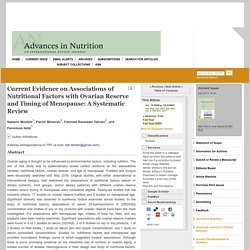
Abstract Ovarian aging is thought to be influenced by environmental factors, including nutrition. The aim of this study was to systematically review current evidence on the associations between nutritional factors, ovarian reserve, and age at menopause. Plant-Based Therapies and Menopausal Symptoms. Importance Between 40% and 50% of women in Western countries use complementary therapies to manage menopausal symptoms.

Objective To determine the association of plant-based therapies with menopausal symptoms, including hot flashes, night sweats, and vaginal dryness. Data Sources The electronic databases Ovid MEDLINE, EMBASE, and Cochrane Central were systematically searched to identify eligible studies published before March 27, 2016. Reference lists of the included studies were searched for further identification of relevant studies. Study Selection Randomized clinical trials that assessed plant-based therapies and the presence of hot flashes, night sweats, and vaginal dryness.
Data Extraction Data were extracted by 2 independent reviewers using a predesigned data collection form. Main Outcomes and Measures Hot flashes, night sweats, and vaginal dryness. Results In total, 62 studies were identified, including 6653 individual women. Are Menopause Supplements Effective? March 2016 Issue Women's Health: Are Menopause Supplements Effective?

By Judith C. Thalheimer, RD, LDN Today's Dietitian Vol. 18 No. 3 P. 18 Today's Dietitian reviews what the research says and which brands are better than others. Practice Bulletin No. 141: Management of Menopausal Symptom... : Obstetrics & Gynecology. Vasomotor and vaginal symptoms are cardinal symptoms of menopause.
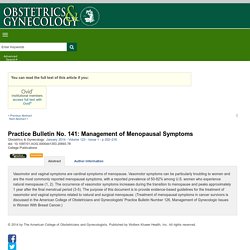
Vasomotor symptoms can be particularly troubling to women and are the most commonly reported menopausal symptoms, with a reported prevalence of 50-82% among U.S. women who experience natural menopause (1, 2). The occurrence of vasomotor symptoms increases during the transition to menopause and peaks approximately 1 year after the final menstrual period (3-5). The purpose of this document is to provide evidence-based guidelines for the treatment of vasomotor and vaginal symptoms related to natural and surgical menopause.
(Treatment of menopausal symptoms in cancer survivors is discussed in the American College of Obstetricians and Gynecologists' Practice Bulletin Number 126, Management of Gynecologic Issues in Women With Breast Cancer.) Committee on Practice Bulletins—Gynecology. Canadian Consensus on Female Nutrition: Adolescence, Reproduction, Menopause, and Beyond. EMAS position statement: Non-hormonal management of menopausal vasomotor symptoms. The ten point guide to the integral management of menopausal health. Tibolone is a synthetic steroid compound that is in itself inert, but whose metabolites have estrogenic, progestogenic and androgenic actions.
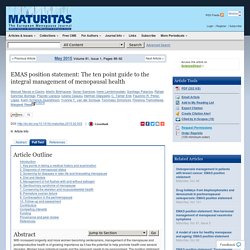
Diagnosis and management of osteoporosis in postmenopausal women and older men in the UK: National Osteoporosis Guideline Group (NOGG) update 2013. The North American Menopause Society Recommendations for Clinical Care of Midlife Women. The role of dietary protein and vitamin D in maintaining musculoskeletal health in postmenopausal women: A consensus statement from the European Society for Clinical and Economic Aspects of Osteoporosis and Osteoarthritis (ESCEO)